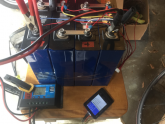MisterSandals
Participation Medalist
Yes, they are likely different, I am trying to learn about each of them.The batteries may have different actual (as opposed to rated) amp/hr capacities.
I reread the thread and craig's cells are, by your explanation, in ascending order of capacity. If randomly selected, I think the odds of that are 12! : 1 (close but not quite exact, sorry).
My cells are, by your explanation, in descending order of capacity. I mistakenly said my order was the same as his, its actually the opposite. This is more troubling to me at the moment. Odds 4! : 1
I think I will equalize them, reverse the order and see if the trend line reverses. (i'm not sure what i'm hoping for!)
I am a little surprised, I would have expected the internal resistances of cells as they progress from 1 upward to have "some" effect on the charging current in subsequent cells (and consistent from one series of cells to another). I rather like the idea that they are exactly the same, it simplifies things quite a bit.Being wired in series, they will all get the exact same charging current,
Last edited:




